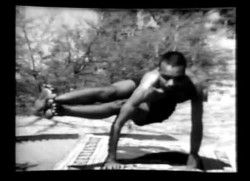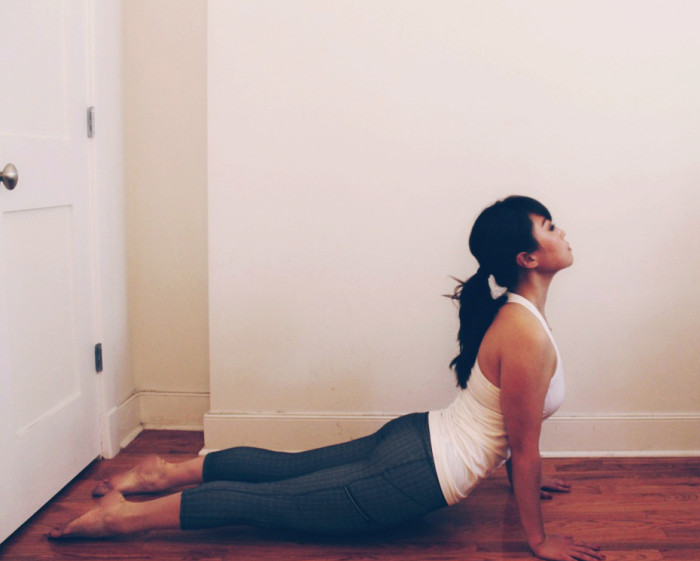After an ego-busting ashtanga class not very long ago, I pursued my teacher. I had tell her that even though I had been practicing yoga for some time, and though I am a 200-hour certified teacher of vinyassa, I am completely humbled on my mat each time I practice ashtanga with her. She informed me that ashtanga is the grandfather of vinyassa, and then went on to tell me that I would be a beginner student of ashtanga for the next ten years if I am to stay with this practice. No instant satisfaction here. Yet, this is what keeps me going to this class. I know that I cannot bring my legs in to a full lotus, nevermind then grab my opposite toes from behind my back. In fact, I think it is impossible. Still, I keep trying. My mind stays intently with my body. I am aware of sensations, pain, and discomfort. I don’t care about my problems when I am busy trying to force my body in to a strange contortion that I may never experience until I am forty-four years old. This is a style I’ve fallen in love with after already having falling in love with three other styles of yoga.
There are many styles of yoga, and the range of physical benefits is broad among the various practices. Some practices are more physically strenuous, while others are blissfully relaxing. Yoga means to yoke the mind, body and soul. The asanas, or postures of yoga, are one way to do so. There are 84 “hundred thousand” postures prescribed by Shiva, and the style that most Americans follow is Raja. The goal of Raja is called Samadhi–to train the mind to become focused in a meditative state often described as blissful. While yoga can be physically challenging, it can be a transformative tool in personal and spiritual growth.
Yoga as we know it essentially began in the late 19th century, when yoga and Sanskit were suppressed by the British. Krishnamacharya was a student of Sri Ramamohan Brachmachari, a yogi who resided in a cave with his wife and three children. After seven years of training, Brachmachari asked Krishnamacharya to open up a school so that this practice would be accessible to the people. After years of juggling yoga with work and living on very little, Krishnamacharya was granted the opportunity to teach at the Sanskrit College in Mysore, and later opened the Yogashala, financed by the Maharaja.
During his years of teaching, three prominent students came to carry on the Yogic traditions, and transformed yoga into what it is today. Western yoga as we know it can be traced back to B.K.S. Iyengar, Pattabi Jois, or Indra Devi. Iyengar was an early student, who learned the postures as we know commonly as hatha style, while Jois learned a more rigorous series which flowed together to keep the attention of the young, energetic men at the school. Indra Devi was the only woman that Krishnamacharya taught. He did not allow women students, but was advised otherwise by the Maharaja of Mysore, and Devi later became one of his most successful students, who taught in China, the Soviet Union, Hollywood (Marilyn Monroe, Elizabeth Arden, and Greta Garbo were some of her students), and finally Argentina where she is highly revered.
From these three students, more and more styles were born. If you have tried one kind of yoga, you haven’t tried it all. There is something for everyone in yoga, but you may have to shop around for the style that suits you.
Here are the major styles of yoga in America:
Ashtanga
Ashtanga yoga was developed by Pattabhi Jois in 1947. It is a regimented series of asana that consist of four parts:
1. Opening Sequence (Including sun salutations)
2. One of the six main series
3. Backbending series
4. Finishing sequence, including inversions
finish in savasana
Ashtanga is humbling. It is said that you are a beginner for ten years, and is a wonderful antidote for ego. Because it is physically challenging, it is a wonderful practice to connect the mind and body, as the mind has few opportunities to float away. The asanas flow in to one-another, creating heat in the body. Ujjayi breath is important throughout the practice, as well as engaging the bandas. Ashtanga is the grandfather (or maybe grandmother) to vinyassa and power yoga.
Hatha
Hatha yoga is a user-friendly yoga that incorporates basic asanas, breath, meditation, and some energy work.
Bikram
Choudhury Bikram developed his namesake yoga thirty years ago. The practice consists of twenty-six postures in a specific order in a room heated to around 105 degrees Fahrenheit. Every teacher is taught by Bikram himself, and classes are conducted in a particular fashion that includes two pranayama practices. You will sweat. You will sweat so much. If you like to detox and sweat, you will love it.
Iyengar
Iyengar yoga pays special attention to alignment. Props such as blankets, bolster, blocks, and straps are commonly used to achieve perfect alignment. It is as mentally demanding as it is physical.
Vinyassa
Vinyassa is somewhat rigorous, as it builds heats in the body, linking asana to asana. There is no specific order, and each class is at the mercy of the instructor. Music, meditation, philosophy and breathing techniques are often infused.
Jivamukti
Jivamukti yoga was developed by David Life and Sharon Gannon in 1984. It is based off of ashtanga, but emphasizes spiritual and ethical philosophies.
Restorative
Mmmmmm. Restorative. Restorative yoga is something everyone can enjoy. The poses are conducted so that the asanas are happening to the body. It is perfect for unwinding or to gently loosen up after a marathon or other endurance challenge.
There are even more styles! Have fun experimenting with yoga styles. Find what makes your heart sing and what makes your body say, “more please!” Namaste.
Also see: 10 Ways to Apply Yoga in Your Daily Life
3 Yoga Breathing Exercises for Self-Healing
Morning Yoga Sequence for Energy


